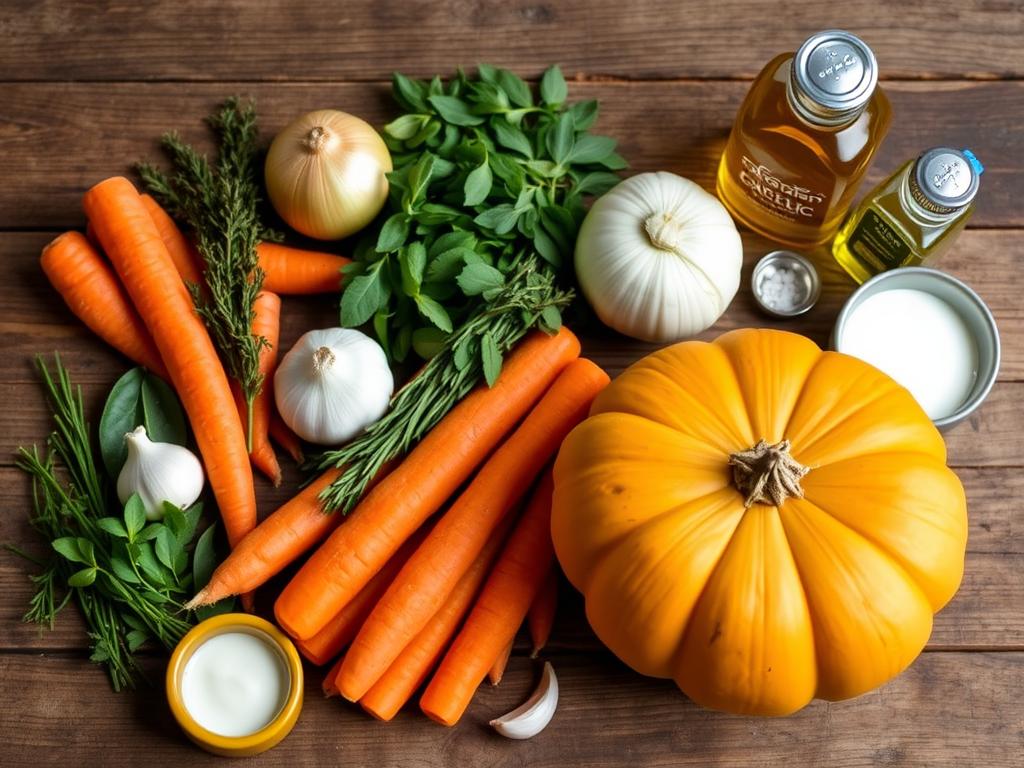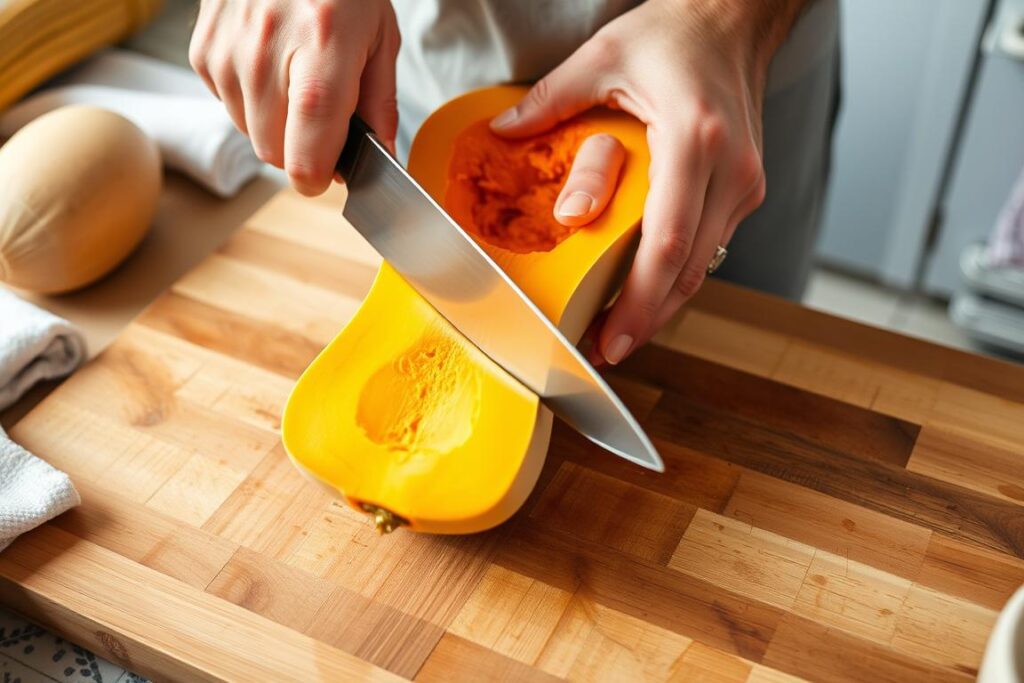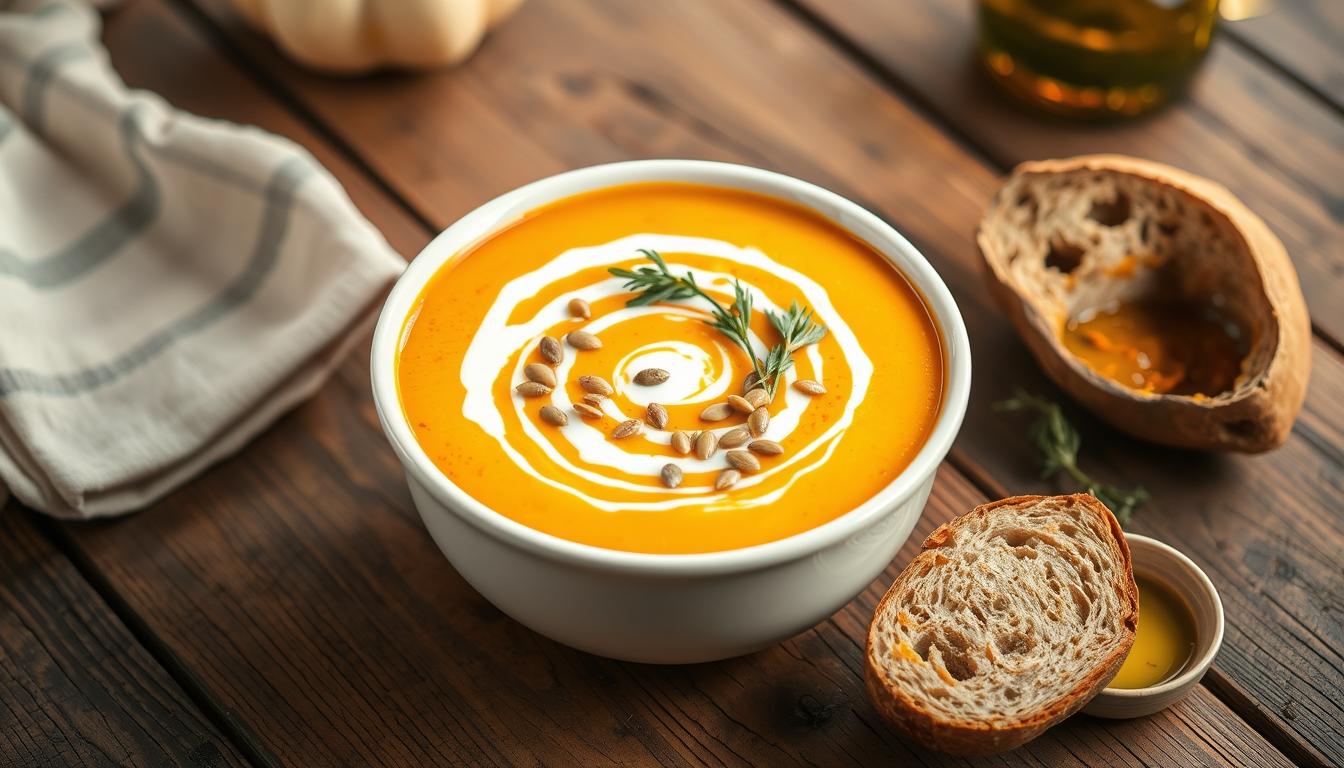Roasted Butternut Squash Soup
When autumn leaves begin to fall and temperatures drop, there’s nothing quite as comforting as a bowl of roasted butternut squash soup. This velvety, golden soup captures the essence of fall in every spoonful – sweet, earthy, and incredibly satisfying. By roasting the butternut squash before blending, you’ll unlock a depth of caramelized flavor that makes this soup truly exceptional. Whether you’re looking for a cozy weeknight dinner or an elegant starter for your holiday table, this roasted butternut squash soup recipe delivers warmth and comfort with minimal effort.
Ingredients for Roasted Butternut Squash Soup

- 1 large butternut squash (about 3-4 pounds), halved and seeds removed
- 2 tablespoons olive oil, plus more for drizzling
- 1 large yellow onion, chopped
- 2 medium carrots, chopped
- 2 celery stalks, chopped
- 4 garlic cloves, peeled and lightly crushed
- 1 tablespoon fresh sage leaves (or 1 teaspoon dried)
- 1 tablespoon fresh thyme leaves (or 1 teaspoon dried)
- 1 sprig fresh rosemary (or ½ teaspoon dried)
- ¼ teaspoon ground nutmeg
- 4 cups vegetable broth (or chicken broth)
- 1 teaspoon maple syrup (optional)
- Salt and freshly ground black pepper, to taste
- Optional garnishes: cream, pumpkin seeds, fresh herbs
This recipe serves 4-6 people as a main course or 8 as an appetizer. The ingredients create a perfectly balanced soup with natural sweetness from the roasted squash and carrots, aromatic depth from the herbs, and a velvety texture that feels indulgent without any added cream (though you can certainly add some if desired).
How to Select and Prepare Butternut Squash

Choosing the Perfect Butternut Squash
When selecting a butternut squash for your soup, look for one that feels heavy for its size with a matte (not shiny) skin. The squash should be firm throughout with no soft spots, and have a beige color without green lines (which indicate it’s underripe). A butternut squash with a longer neck and smaller bulb end will give you more flesh and fewer seeds.
Safe Cutting Technique
Butternut squash can be challenging to cut due to its hard exterior. For safety, use these tips:
- Use a sharp chef’s knife and a stable cutting board
- Microwave the whole squash for 2-3 minutes to slightly soften the skin
- Cut off both ends first to create stable flat surfaces
- Stand the squash upright on the wider end and carefully slice down the middle
- Use a spoon to scoop out the seeds and stringy parts
If cutting a whole butternut squash seems daunting, many grocery stores now offer pre-cut butternut squash in the produce section, which works perfectly for this soup recipe.
Step-by-Step Cooking Instructions

- Preheat your oven to 425°F (220°C). Line a large baking sheet with parchment paper.
- Prepare the butternut squash. If using a whole squash, cut it in half lengthwise and scoop out the seeds. Drizzle the cut sides with olive oil and season with salt and pepper. Place cut-side down on the baking sheet. If using pre-cut squash, toss the cubes with olive oil, salt, and pepper on the baking sheet.
- Add aromatics to the baking sheet. Arrange the onion, carrots, celery, and garlic cloves around the squash (or mix with the squash cubes). Drizzle everything with a bit more olive oil and sprinkle with the herbs.
- Roast for 40-50 minutes, until the squash is completely tender when pierced with a fork and the vegetables are caramelized at the edges. If using halved squash, the skin should be easily pierced with a fork.
- Let cool slightly, then scoop the squash flesh from the skin if you roasted halves. Transfer all roasted vegetables to a large pot.
- Add the vegetable broth, nutmeg, and maple syrup (if using) to the pot. Bring to a simmer over medium heat and cook for 5-10 minutes to allow the flavors to meld.
- Blend until smooth. For the best texture, use an immersion blender directly in the pot. Alternatively, carefully transfer the soup in batches to a standard blender (be cautious with hot liquid).
- Return to the pot if you used a standard blender. Adjust the consistency with more broth if needed, and season with additional salt and pepper to taste.
- Serve hot with your choice of garnishes.
Pro Tip: The key to exceptional flavor in this soup is properly roasting the vegetables until they’re deeply caramelized. Don’t rush this step – those browned edges contain incredible flavor compounds that make all the difference!
Blending Techniques for Silky Smooth Soup

Achieving that perfect velvety texture is essential for a restaurant-quality butternut squash soup. Here are your options for blending:
Immersion Blender Method (Recommended)
An immersion blender (also called a stick blender) is the easiest and safest option for hot soup:
- Keep the blender head fully submerged while blending to avoid splatters
- Start on low speed and gradually increase
- Move the blender around the pot to ensure all chunks are pureed
- Blend for 1-2 minutes until completely smooth
Standard Blender Method
If using a countertop blender:
- Allow the soup to cool slightly before blending
- Work in batches, filling the blender no more than halfway
- Remove the center cap from the blender lid and cover with a kitchen towel to allow steam to escape
- Start on low speed and gradually increase
- Return the blended soup to the pot and stir to ensure consistent texture
“The secret to the silkiest butternut squash soup is taking your time with the blending process. A few extra minutes here makes all the difference between a good soup and an exceptional one.”
Delicious Variations and Modifications
Apple-Ginger Variation

Add 1-2 peeled and chopped apples to the roasting pan with the vegetables, and include 1 tablespoon of fresh grated ginger. The apples add natural sweetness while the ginger brings a warming zing that complements the squash beautifully.
Coconut Curry Version

Replace 1 cup of the vegetable broth with coconut milk and add 1-2 teaspoons of curry powder when simmering. This creates a rich, exotic flavor profile with a hint of sweetness from the coconut milk that pairs wonderfully with the butternut squash.
Vegan Creamy Version

Make a dairy-free cream by blending ½ cup soaked raw cashews with ¼ cup water until completely smooth. Stir this into the finished soup for incredible richness without any dairy. Add a squeeze of lemon juice to brighten the flavors.
More Ways to Customize Your Soup
Add Protein
- Stir in cooked quinoa or lentils
- Top with crispy bacon bits (non-vegan)
- Add roasted chickpeas as a garnish
Spice It Up
- Add ¼ teaspoon cayenne for heat
- Include ½ teaspoon smoked paprika
- Try ¼ teaspoon cinnamon and a pinch of cloves
Make It Heartier
- Add a peeled, diced potato to the roasting pan
- Stir in cooked wild rice before serving
- Mix in sautéed mushrooms for umami flavor
Alternative Cooking Methods
- Slow cooker: Cook on low for 6-8 hours after roasting
- Instant Pot: Pressure cook for 8 minutes after sautéing
- Stovetop only: Simmer diced squash with vegetables for 30-40 minutes
Serving Suggestions and Garnish Ideas

Elevate your roasted butternut squash soup from simple to spectacular with these serving ideas:
Perfect Garnishes
Crunchy Toppings
- Toasted pumpkin seeds
- Homemade croutons
- Crispy fried sage leaves
- Toasted pine nuts
Creamy Additions
- Swirl of heavy cream
- Dollop of Greek yogurt
- Coconut cream (vegan)
- Crème fraîche
Fresh Finishes
- Minced fresh herbs
- Microgreens
- Drizzle of olive oil
- Freshly cracked black pepper
What to Serve With Butternut Squash Soup
Make a complete meal by pairing your soup with these complementary sides:
- Crusty bread or rolls for dipping
- Grilled cheese sandwich made with sharp cheddar or gruyère
- Simple green salad with vinaigrette dressing
- Roasted brussels sprouts or other seasonal vegetables
- Warm grain salad with farro or quinoa
“Butternut squash soup makes an elegant first course for Thanksgiving dinner, or a satisfying main dish when served with hearty bread and a salad.”
Storage and Reheating Instructions

One of the best things about roasted butternut squash soup is that it stores beautifully and often tastes even better the next day as the flavors continue to develop.
Refrigerator Storage
- Allow soup to cool completely before refrigerating
- Store in airtight containers for 4-5 days
- If the soup thickens in the refrigerator, thin with a little broth when reheating
Freezer Storage
- Freeze in airtight containers, leaving 1 inch of headspace for expansion
- Alternatively, freeze in silicone molds or ice cube trays for individual portions
- Soup will keep in the freezer for up to 3 months
- Thaw overnight in the refrigerator before reheating
Reheating Methods
- Stovetop (best method): Reheat over medium-low heat, stirring occasionally
- Microwave: Heat in 1-minute intervals, stirring between each
- Slow cooker: Warm on low setting for 1-2 hours (great for parties)
Make-Ahead Tip: This soup is perfect for meal prep! Make a double batch on the weekend and enjoy quick, nutritious meals throughout the week. The soup also freezes beautifully for up to 3 months.
Nutritional Benefits of Butternut Squash Soup

Beyond its delicious flavor, roasted butternut squash soup is packed with nutrients that support overall health. Here’s why this soup deserves a regular spot in your meal rotation:
Key Nutrients in Butternut Squash
- Vitamin A: One serving provides over 200% of your daily requirement, supporting eye health and immune function
- Vitamin C: Boosts immune system and promotes collagen production
- Potassium: Helps regulate blood pressure and fluid balance
- Fiber: Supports digestive health and helps maintain steady blood sugar
- Antioxidants: Contains beta-carotene and other compounds that help fight inflammation
Health Benefits
- Immune Support: The combination of vitamins A and C helps strengthen your immune system
- Heart Health: Potassium and fiber contribute to cardiovascular health
- Weight Management: High fiber content helps you feel full longer
- Anti-Inflammatory: Contains compounds that may help reduce inflammation
- Skin Health: Vitamins A and C support healthy skin
Nutrition Fact: A typical serving of this roasted butternut squash soup (about 1½ cups) contains approximately 150-200 calories, making it a nutritious and satisfying meal option that’s relatively low in calories.
Frequently Asked Questions
Can I use pre-cut butternut squash for this soup?
How can I make this soup thicker or thinner?
Is this soup vegan?
Can I make this soup without a blender?
What can I substitute for butternut squash?
Time to Enjoy Your Homemade Roasted Butternut Squash Soup!

With its rich flavor, velvety texture, and impressive nutritional profile, roasted butternut squash soup deserves a place in your regular meal rotation. The roasting process might take a little time, but the depth of flavor it creates is well worth the effort – and most of that time is hands-off while your oven does the work!
This soup is incredibly versatile – serve it as an elegant starter for a dinner party, pack it in a thermos for lunch, or enjoy it as a comforting dinner with some crusty bread. The leftovers taste even better the next day, making it perfect for meal prep.
As the weather turns cooler, treat yourself and your loved ones to this nourishing, comforting bowl of sunshine. Your kitchen will be filled with amazing aromas, and your body will thank you for all those nutrients packed into each delicious spoonful of roasted butternut squash soup.
Did You Make This Roasted Butternut Squash Soup?
We’d love to hear how it turned out! Leave a comment below and share your experience. Did you try any variations? What garnishes did you use? Your feedback helps other readers!

